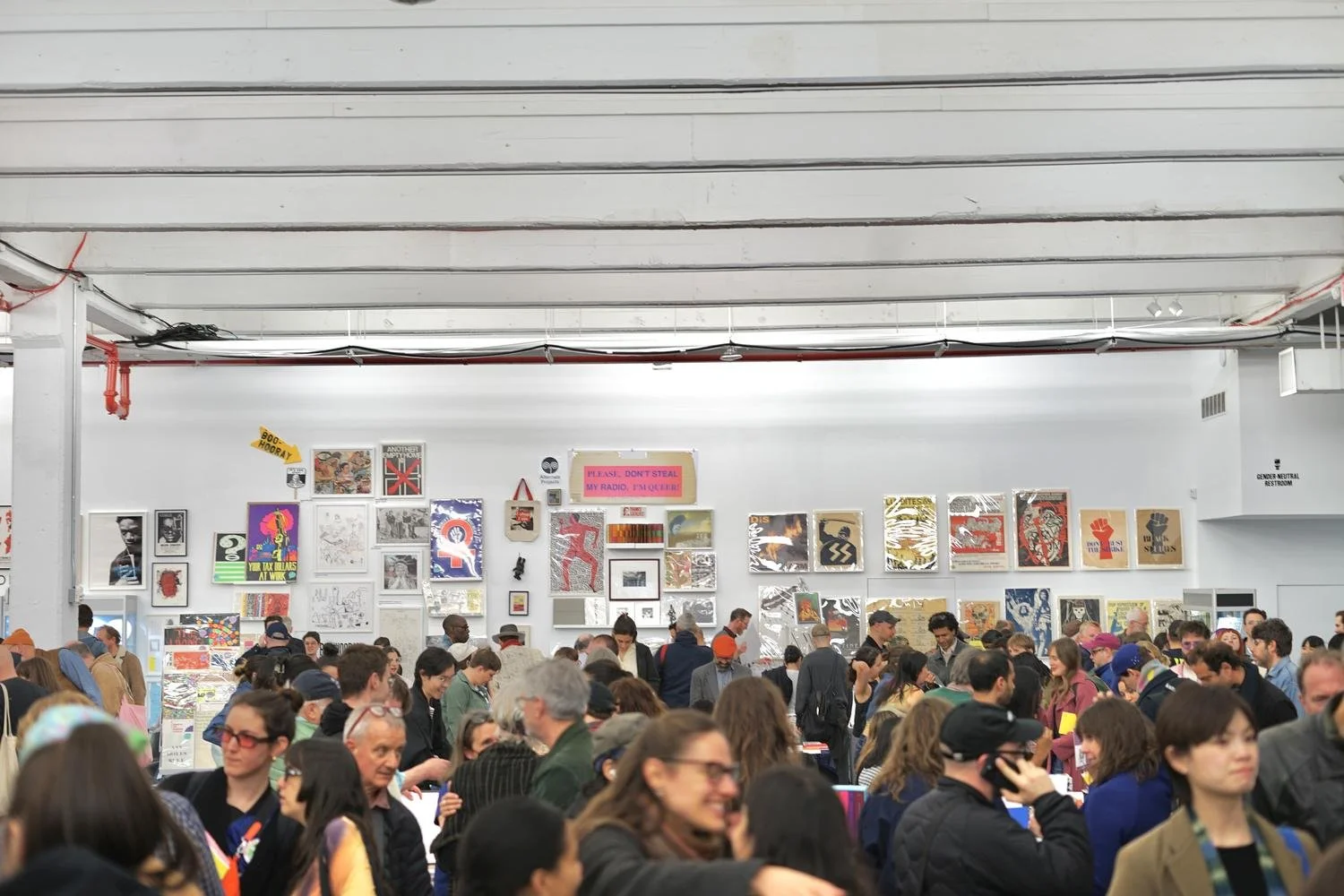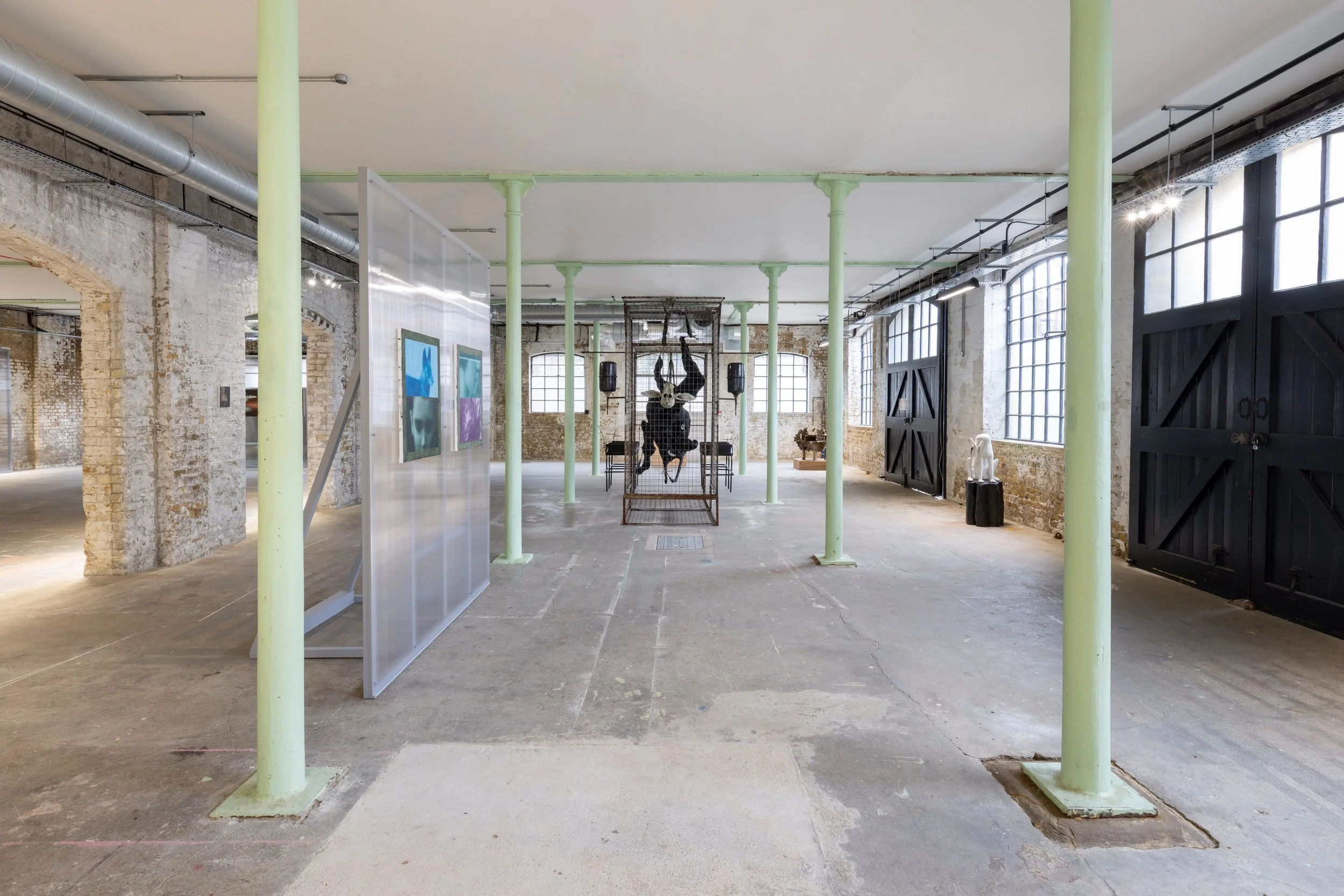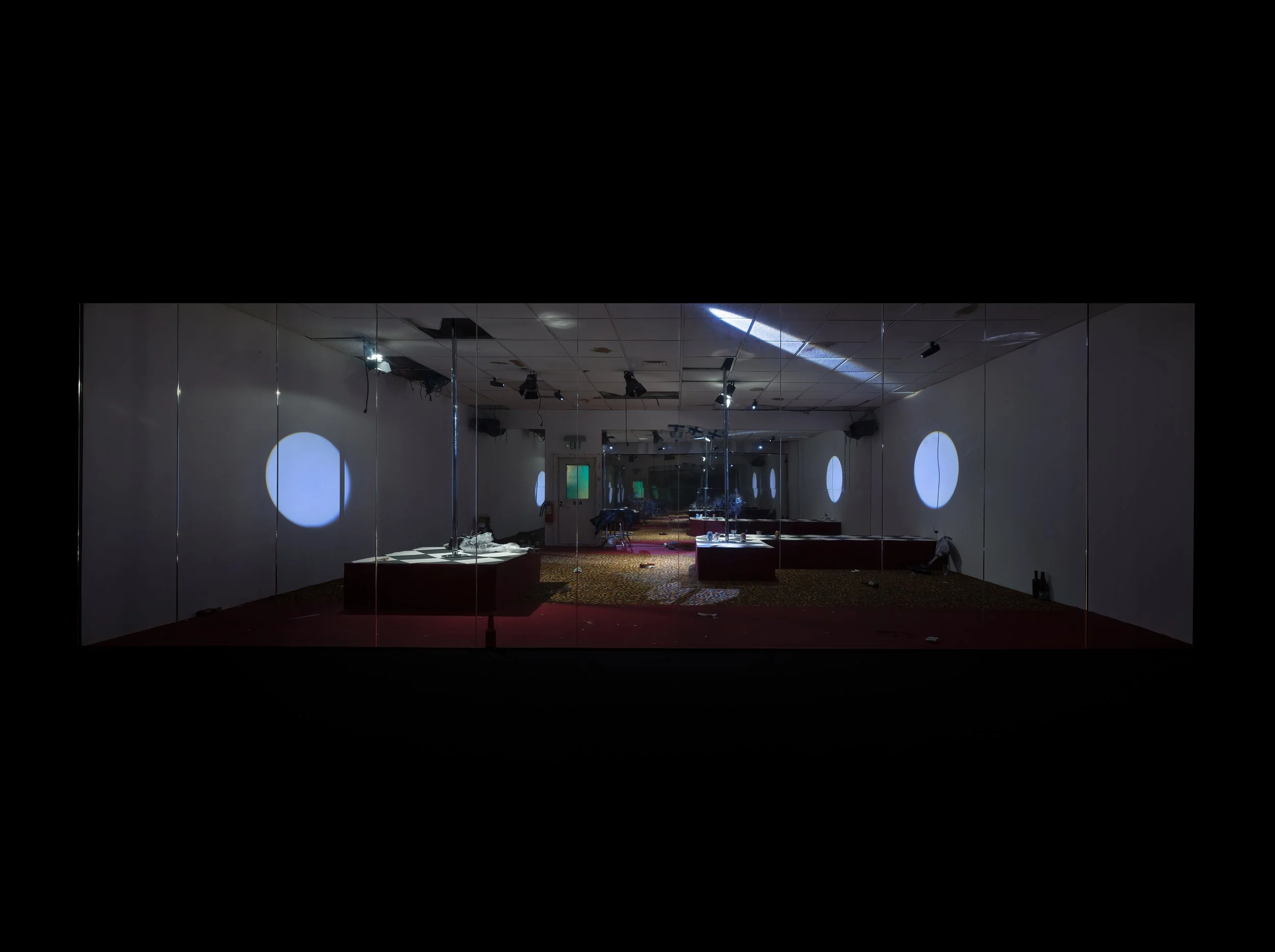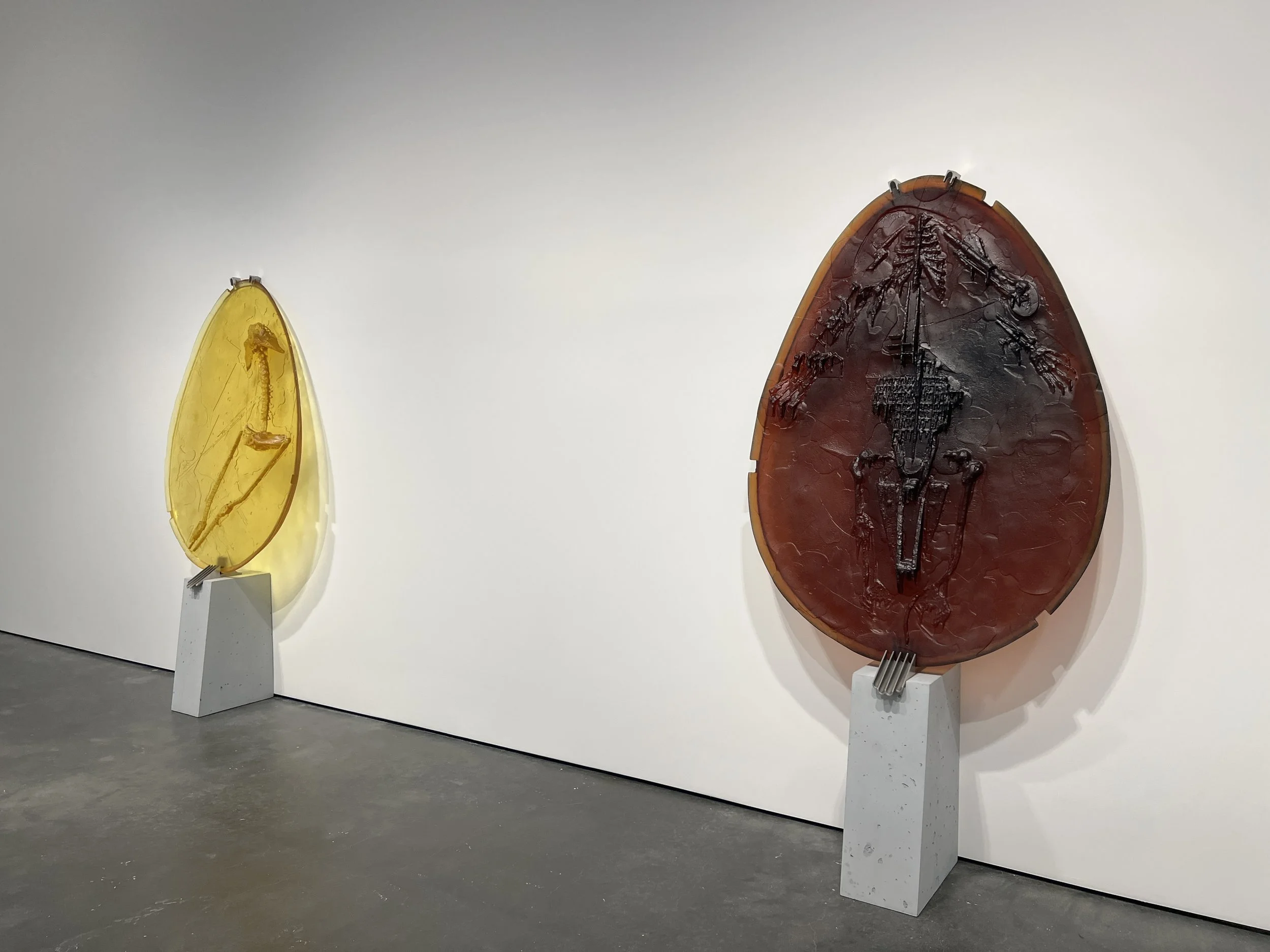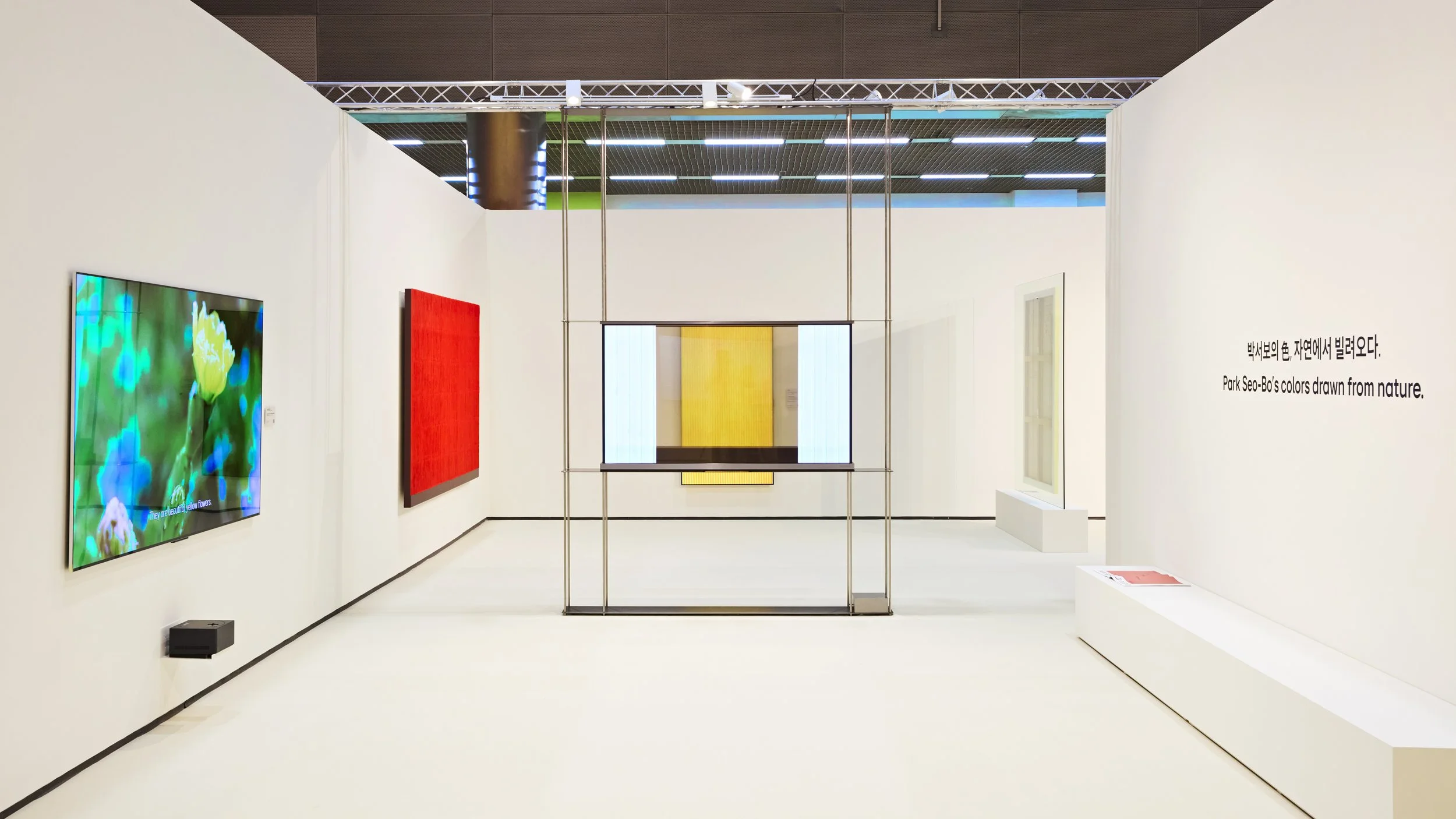Editors’ Selects: September 2025
Printed Matter New York Art Book Fair
MoMA PS1 | 22-25 Jackson Ave, Queens
September 11 – 14, 2025
Printed Matter’s New York Art Book Fair (NYABF) is back at MoMA PS1 for the first time since 2019 and remains the best source of artist books, ephemera, small press publications, one-off t-shirts, and more. With over 250 exhibitors from 34 countries, this is one of the rare occasions where there really is something for anyone, no matter what your niche aesthetic or intellectual interest.
Highlights included the zine tent, where available are “I break for artist run spaces” bumper stickers by California-based CA53776V2.gallery, publications and tie-dyed handmade apparel by Florencia Escudero of Precog Magazine, and the Exhibitor Projects, which included an archival exhibition about “queer collective of revolutionary guerrillas” Les Petites Bon Bons, organized by Boo-Hooray.
What makes the NYABF special this year is the palpable excitement that comes with the return to MoMA PS1, which allowed the fair to sprawl out in all of its glory. Along with the different booths and exhibitions, the courtyard of PS1 is continuously activated with music, poetry, and performance, shrugging off all art-world snobbery for joyful celebration and discussion. Every exhibitor was thrilled to talk about the contents of their table, which ranged from established names like Gagosian to inaugural Printed Matter Publisher Work Grant recipient, Chilean lesbian publishing initiative HAMBRE HAMBRE HAMBRE. Even if you don’t find anything you want to take home with you (unlikely), you’ll walk away with a renewed excitement for collective creative endeavors and at least a few new friends.
— Taylor Bluestine
Maggie Hazen & the Columbia Collective: Fraught Imaginaries
Transmitter | 1329 Willoughby Ave. 2A, Brooklyn
August 23 – October 5
A sign that reads “Smile, you’re on camera” greets every visitor who enters Transmitter, while a defunct security camera comically adorned with a googly eye hangs above the door, watching. These works in the gallery’s doorway set the tone for the space that the viewer is about to enter: a site of surveillance and confinement that is at once playful and dark, as lighthearted as it is cynical. Maggie Hazen’s Fraught Imaginaries was made about and in collaboration with a group of female and trans incarcerated artists held in a maximum security juvenile prison, who, under Hazen’s mentorship, formed the Columbia Collective. Referencing the panoptical architecture and prison economy to which these incarcerated persons are subjected in confinement, Hazen’s sculptural installations, drawings, and video work imbue the childlike back into carceral bureaucratic apparatuses.
Taking up a significant portion of the gallery is Hazen’s work Supply 🌀Demand (2024). Bricks comprised of materials sourced from the prison industrial supply chain form three corners of a wall and create an open spiral, inviting the viewer within its boundaries. Upon close inspection, many ubiquitous commodities appear recognizable within the brick’s structure: Cheetos, pencils, a pair of shoes encased in cement, toilet paper, toothbrushes, The Bell Jar by Sylvia Plath, pretzel sticks, tampons, and much more. Hazen purposefully left the structure open to visualize “a way out” of the carceral system, rather than simply replicate its closed boundaries. On the floor around it, cut-outs of prison catalogues featuring items for inmates’ families to purchase for them are scattered, highlighting the commodification processes mobilized by the prison industrial complex to extract revenue from incarcerated people.
The exhibition features two of Hazen’s drawings of the Columbia Secure Center for Girls’ interior, displayed in aluminum “tamperproof” display cases that were sourced from the facility. The larger piece, ______ (2024), uses a kaleidoscopically filtered source image and introduces bright colored pencil, transforming the prison architecture into a sort of psychedelic fun-house mirror. Hazen uses the distorted image to work around the strict policies that prohibit the circulation of photos taken within the facility. The same policies also forbid the public release of the inmates’ faces and identities, which explains the pseudonyms used by Columbia Collective members: Jay, Juste-A, Marilynn, Marshmallow, and Rory Rei.
Hazen’s video piece Soapy 🧼 (2024) works around censorship policies in a different way, displaying a video of the inmates through Snapchat filters, which in turn is placed within a soap dispenser covered with brightly colored kids’ stickers. The content of the video is literally and metaphorically sanitized when it reaches us. Its deeply political and critical content, like that of the entire show, is packaged within the aesthetics of childhood innocence, nostalgia, and play, like illicit goods being smuggled through prison security. Fraught Imaginaries flips the carceral system’s tactics on its head by reintegrating youth back into the juvenile inmate and the structures that surround them.
— Jonah James Romm
PEDIGREE
OHSH Projects | 12 Ossory Road, London
August 7 – September 21, 2025
Muzzled and watchful, half-menace and half-mascot, Irena Posner’s Dobermann sculpture sits erect at the door, introducing PEDIGREE, the latest exhibition from OHSH Projects. Curated by Henry Hussey and Sophia Olver, PEDIGREE gathers artists across generations, from established individuals to recent graduates. The curators take a simple yet inexhaustible theme—the dog—and open it to a wide field of perspectives, so numerous it feels impossible to account for them all. The mix includes artists who had long been making work about dogs, and others who created pieces specifically for the exhibition.
Founded in 2021, OHSH Projects has repurposed otherwise vacant real estate into temporary cultural sites. The model makes space for artists where none formally exists, while also brushing against the economics of ownership and displacement. What purpose does this serve? Political inquiry? Decoration for spaces in flux? PEDIGREE doesn’t resolve these questions, but reflects them, installing works about intimacy and control inside a property being prepared for its next use.
Tulani Hlalo’s contribution takes these notions into performance. Her videos and textile sculptures explore the world of competitive dog grooming, where poodles are dyed and shaped into living ornaments. What fascinates Hlalo is the question of canine self-perception. If dogs recognize each other by smell rather than reflection, what happens when their coats are chemically dyed and perfumed? In her performances, Hlalo steps into both roles, groomer and groomed, wearing layered costumes and oversized rosettes. Here, grooming hovers between care, cruelty, protection, and display.
Samantha Fellows’s paintings take the dog as both image and collectible, embracing slipperiness and capturing fleeting sensations. In her work, the dog becomes a token, like a cigarette card or baseball card—part of a set to be collected, displayed, and exchanged. Breeding follows the same logic of customization: humans alter living beings for utility or amusement, distorting their bodies through inbreeding and cosmetic standards. Fellows’s focus on fleetingness sharpens this contradiction: the same animals bred to carry our projections are left fragile, sickly, dependent—symbols of use and taste whose lives are often shortened. Her work suggests that the drive to preserve a moment of beauty or novelty is inseparable from the urge to engineer it, however destructive. In the weakness of these creatures, do we seek confirmation that we, too, can be cared for? Fellows’s paintings show domestication as both control and projected fantasies of nurture and vulnerability.
There is much more that could be said—other works in PEDIGREE address social expectations and the ways bodies and personas shift through rituals of transformation. They hint at futures where the line between species and machinery is no longer clear. In PEDIGREE, what emerges is an observation of how humans continually remake themselves through other living bodies.
— Pola Pucheta
Vladislav Markov: OBJECTS IN MIRROR MAY BE CLOSER THAN THEY APPEAR
Management | 39 E Broadway, 404, New York
September 6 – October 26, 2025
Until October 26, those who enter Management step into a black box and face a row of floor-to-ceiling windowpanes. Beyond them, fluorescent spotlights expose two checkerboard stages with stripper poles. Between the stages, a red carpet with a cheetah print rug strewn atop. Surfaces are littered with cans and other ambiguous debris. OBJECTS IN MIRROR MAY BE CLOSER THAN THEY APPEAR becomes the “seedy strip club” as described in the press release, installed in the gallery space under Vladislav Markov’s direction.
A glaring particularity of this club is the audience’s situation relative to the stage. The looking glass that separates the viewer is one-sided; it is a mirror for those enclosed. With the help of projectors and color filters, amputated performers equipped with custom Markov prosthetics take stage in a space that appears to be “produced by a malfunctioning computer.”
In a past piece titled Thank me I didn't do it earlier and yes you can message (2024), Markov placed mirrors beneath a 3D printer to disrupt the printer’s spatial sensing. The printer relies on a legible surface on which to map the digital input into a physical output. When what should be a concrete surface is simply a reflection of the sensor, the physical output of the printer is an eerily distorted trace of the input. The printer’s point of reference is perpetually displaced. In a similar vein, OBJECTS IN MIRROR challenges those outside to observe a system, or a subculture, that glitches as it materializes.
In the press release, Nicolas Bourriaud writes that “we now perceive the world through interfaces that shape our perception.” He is correct, but perhaps neglects that we have always perceived the world through interfaces—it’s simply that the interfaces change. Markov is realistic in that he replicates voyeuristic conditions that enable a viewer to fetishize and consume. The interface materializes before the viewer from beyond the glass. The distorted reality present in the piece doesn’t simply mimic the interaction between humanity and digital technology. The presence of the glitch, a product of error in self-perception, enables the dynamics of the piece to unfold.
If not for the error—“deteriorated code fragments”—the overlaid patterns that form a subculture’s identity are more easily co-opted as commodities. It is commodification that severs the object from the relations that embed its cultural significance. The glitch-space that Markov constructs resists this habit and allows the viewer to glimpse the Gustave Courbet reality that Bourriaud touts, while also prompting viewers to assess the ease with which the “dimly lit corners of existence” are commodified.
— Tobias Olson
Last Art School
Hunter Art Galleries | 205 Hudson St, New York
August 27 – November 22
Upon entering Last Art School in the Hunter College Art Galleries, visitors may think they’ve intruded upon the MFA program’s cafeteria, where students are gathered around tables drinking free coffee, eating pretzels, and chatting. This isn’t a cafeteria, though—it’s a curatorial intervention by Lindsey White called Chat & Chew, where artworks are installed among tables and chairs to invite sociality and community within the gallery space. Adjacent to the entrance hangs a bulletin board filled with recent news headlines regarding the crisis in higher education: “Harvard faculty won’t cave to Trump demands,” “Columbia Got Most of Its Research Funding Back. The Damage Goes Deeper.” Set against the backdrop of crumbling integrity amongst institutions of higher education, Last Art School posits itself as a site of unique resistance founded on social relations and artistic experimentation.
Selections from the Rhoda Kellogg Children’s Art Collection and the San Francisco Art Institute Legacy Foundation and Archive are displayed alongside the artwork in this exhibition. The latter takes up the majority of one of the corner galleries, where documents from the school’s history and ultimate closure in 2022 are hung. The installation highlights various themes ranging from the political—“FREE SPEECH” and “WAR”—to the absurd and comical—“TURD PATROL”, “PUNK” and “BLOOD”—illuminating the dynamic troubles the institution faced throughout its history. On one wall, a photo of SFAI’s windows covered in big red Xs and painted to read “Budget Cuts No View” testifies to the virile student protests and revolutionary attitude that defined the school right up to its closure. In Last Art School, the archive gives an account of resistance within academic institutions and provides a model for continuing this legacy.
Further in, the presentation begins to paint a picture of Lindsey White’s academic career, the artist-curator approaching the exhibition like a work of autofiction. Having taught at SFAI for about a decade before its closure, the archive lays the background for the show, which is a mix of work by White and her former colleagues, friends, and students. In one room plays White’s three-channel video Closed for Business (2023), which contains footage from the deserted SFAI campus during the Covid-19 pandemic, hanging in limbo. White’s work is reminiscent of Louise Lawler’s photography of works within galleries and museums, applying the attitude of institutional critique to the sphere of arts education.
Last Art School can also be read through the framework of relational aesthetics, where the artwork creates and interrogates social relations. The Chat & Chew, which serves free lunch every week, no doubt inherits its form from Rirkrit Tiravanija’s pad thai situations. In this case, however, the relational form blurs the line between curatorial and artistic methods, as the exhibition functions both as an environment and as an illustration of White’s specific social history through the artists included. By framing this intervention in the context of Hunter, Last Art School becomes a microcosm of the social, communal, and artistic connections that constitute an educational program and offer a model for its survival.
— Jonah James Romm
Andra Ursuța: Retina Turner
David Zwirner | 537 West 20th Street, New York
September 10 – October 18, 2025
Within David Zwirner’s cavernous Chelsea location, Andra Ursuța presents a series of otherworldly sculptures that, in unison, invent an eerie spectacle reminiscent of a nest of glass ghosts and apparitions suspended in time. The sixteen glass slabs in Retina Turner invoke the imagery and composition of a fossil and feature a diverse range of eye-catching textures and colors that extend into an extraterrestrial realm. Utilizing the organic shape of the egg as a container constructed from hard yet fleshlike materials, there is a noticeable contrast between the sterile environment of an art gallery and the seemingly living, pulsating art.
Witnessing spectators closely examine the eggs and freely navigate through the gallery felt almost ominous, as if at any moment the abstract forms in these sculptures, which Ursuța titles as Private Dancers, could break free from the confines of the crystalline surface and wreak havoc upon the unsuspecting room. Ursuța’s works on view demonstrate a clear mastery in form and a profound understanding of visual storytelling: there is a deep tension permeating from the collection, similar to the gentle unease experienced in a psychological horror film. The sculptures oscillate from haunting to captivating, from visual clarity to obscurity.
Each sculpture is presented like a scientific specimen to be studied and dissected to discover its origin and meaning. My immediate assumption upon first viewing the sculptures was that Ursuța had imagined a post-apocalyptic world, and these “fossils” would serve as artifacts to show the remnants of our society. One guest I spoke to saw the exhibition as an embodiment of sex, with each egg sculpture being an inhabited womb; another spoke about the ectoplasm of ghosts, while another reflected on the fixed and fluid nature of temporality. Each sculpture simultaneously contains the germinating yet already fossilized makeup of death, scientific discovery, architectural expansion, the natural, and the artificial. The fragmented display of these forms and the paradoxical nature of ambiguous temporality suggest their interconnectedness and mutual reliance on one another for both propagation and destruction.
Accentuating the intricate visual allure of hesitance and curiosity is the seemingly gelatinous texture of the sculptures, demanding to be touched while offering a stern warning to not get too close or else risk being sucked into the scene, a warning only amplified by Zwirner’s near-ceremonial space. In lieu of getting the satisfaction of feeling the work, the next best sensation was looking at something both mesmerizing and visually overwhelming.
— Ciaran Short
Jeannie Rhyu: Entanglement
NOoSPHERE Arts at Kingsland Wildflowers | 520 Kingsland Avenue, Brooklyn
June – October 2025
Our ancestries are shaped by quantum physics, specifically the quantum spin mechanism. This theory maintains that each of us—and all particles present in the universe—holds a tiny magnet within ourselves, drawing us closer and keeping us connected to our origins, even as we travel away or beyond. Whether magnetically tying us to the places or people we call home, these connections travel with us, even once we physically leave them.
For Korean Canadian artist Jeannie Rhyu, “birds are the ultimate migrants, capable of teaching us how to have your heart in two places at once and how to navigate the path home.” But this begs the question of what it means to be the “ultimate” migrant. Must home be a place you move toward or leave behind? Can it only be one?
Across the Atlantic Flyway, specifically over Newtown Creek in Greenpoint, many species such as the Barn Swallow, Yellowthroat, Black-Crowned Night Heron, and Double-Crested Cormorant use the quantum spin to orient their yearly migration towards their ancestral breeding grounds, a feeling and particle entanglement very familiar to immigrants arriving in or leaving New York. Entanglement, Rhyu’s installation at NOoSPHERE Arts activating Kingsland Wildflowers’ Green Roof, nests four pairs of ceramic eggs amongst wildflowers, recording the stories, journeys, and legacies of these four birds migrating through the area. By rerouting the quantum connections between these avian species and Newtown Creek, each egg constitutes a preciously fragile story in and of itself. Just like the Newtown Creek Wastewater Treatment Plant dominating Kingsland’s skyline, Rhyu’s eggs recycle and repropose histories of species that have cultivated the area. Migration here becomes the action of recycling and rebuilding a relationship with our surrounding habitats, chosen or not. In this way, the quantum spin ensures the connection between place, people, and particles navigating the universe as mutually constitutive.
As the installation lives its duration from June to October 2025, wildflowers continue to grow around each egg, curating a new pathway towards finding their pairs, but also obscuring parts of each story. Soon, the flowers will envelop the eggs’ individual markings, making it difficult to view each species’ recorded legacy. Rhyu’s eggs will become undiscoverable. This quantum entanglement maintains that there can be no “ultimate” migrant, as migration takes form and resonance over time, habitats, and the way these journeys are told, or ignored.
Home, then, is not only the tiny magnets tying us all to each other, but the stories we tell over time. It is the act of leaving a mark—or egg—behind for the next person to pick up and pass on. Rather than a traceable site or pinpointable identity, home is a story in constant entanglement.
— Agnese Fanizza
Park Seo-Bo x LG OLED: Colors Drawn from Nature
Frieze Seoul | COEX, Gangnam, Seoul
September 3 – 6, 2025
In a world that tussles with honoring the old ways of life while embracing the digital age, Park Seo-bo Foundation’s collaboration with LG OLED addresses this friction through a renewed perspective and gentle ease.
Park Seo-bo, a pioneering figure in Korean contemporary art and the Dansaekhwa movement, left behind contemplative work rooted in repetition, nature, and healing. He did not engage with technology; his art was grounded in materiality and presence. This posthumous collaboration extends his vision into the digital realm, honoring the tangible while opening space for new conversations.
“When NFTs were in vogue, many proposed turning my father’s works into NFTs. He always declined,” shared Park’s son, Sam Seungho Park. “‘That is not my world,’ he said. He saw digital media not as a tool for commodifying his work but as a way to archive it: ‘Digital belongs to younger artists. If my works are turned into commodities through digital means, then they are no longer mine.’”
Presented at Frieze Seoul, the exhibition showcased ultra-high-resolution digital stills of Park’s original paintings on LG OLED TVs, alongside select canvases with the artist’s handwritten notes on their reverse sides. The result is a subtle yet piercing conversation, reflecting the artist’s enduring question: What role can painting assume in the 21st century?
“We extended this question to ourselves and the audience,” said curator Valentina Buzzi. “It’s fascinating to use technology as a medium to bring possibilities alive that physical mediums alone cannot achieve. LG OLED enhances aspects of Park Seo-Bo’s opus not easy to unveil to the audience.” Through the advanced color resolution of the screens, Park Seo-Bo’s colors are revealed with striking clarity. This exhibition highlights the natural colors he rediscovered in nature, using technology to bring forth those vivid hues.
“As my father grew older, he believed art’s purpose was not to assert presence but to communicate quietly with viewers, helping them recover peace within themselves,” said Seungho Park. “He saw art as healing.” This quiet reflection contrasts sharply with today’s fast-paced world. “We saw an art fair as a perfect metaphor for our rushed, always-on lives,” explained Buzzi. The contrast created a uniquely memorable experience.
— Shreya Ajmani

